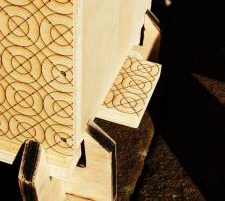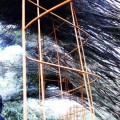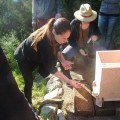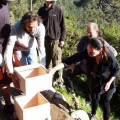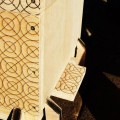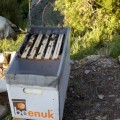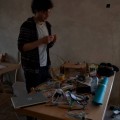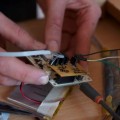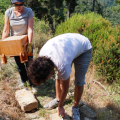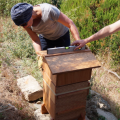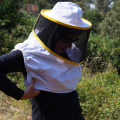April 10/11/12 2012 part#1 of the Bee Monitoring sessions was organized at Valldaura. The first part of the project focuses on the monitoring of beehives through sensors while exploring different materials and appliances of the beehive itself. The idea is to consider the bees themselves, and their behavior and reactions, as sensors of the environment that inform us on the quality of air, water, the diversity of plants … sensors of nature and a healthy environment. The current interns prepared for the wokshop by building a natural structure with the local materials. This structure will be used to give shadow to the area where the first beehive will be placed. It will be extremely important during the hot, dry summer days. Annemie Maes, from OKNO, a Belgian non-profit organization, conducted the workshop where the interns were introduced to the basics of apiculture, beekeeping, and the nature of bees in general.
FabLab Academy students have been working for weeks, building an open structures beehive. They constructed three items, one to be located on the rooftop of Iaac, one for Valldaura, and one for Okno. The beehives will be filled with sensors (temperature, humidity, Co2, dust). The sensors will track changes inside the beehive and allow us to study how environmental factors affect the beehive and bees’ behavior, as well as how that data can be used as an environmental sensor itself.
The first open source Warré beehive was assembled by the interns, guided by Annemie Maes, and placed in the area that had been prepared for it the previous days.
Part#2 (2 en 3 mei 2013) van de workshop series. De eerste dag zijn we de zwarte bijen gaan halen (Apis mellifera mellifera) in Lleida, 2 uur rijden van BCN, binnenland Catalunya. De bijen kwamen mee in een verluchte kartonnen doos, en ze zaten al op topbars van Warre-maat: 5 frames en 1 koningin.
Toegekomen op de Valldaura-site prepareren we de transfer van de travelbox naar de warré hive. John (zijn eerste job als newbee beekeeper) heeft net de sensors afgewerkt. 2 T° en 1 humidity inside, T° en humidity outside. Hij zal de data elke nacht via een laserconnectie doorsturen naar het Valldaura huis, vermits de site geen wireless heeft. De data worden nu tijdelijk gesaved op een SD card die op de smart arduino met bee-shield gemonteerd is. De sensors en smart arduino worden gepowerd door een zonnepaneel dat naast de hive staat. Hier maakt John de connectie met het panel. Connectie van sensors en arduino werkt, data komen binnen en worden opgeslagen.
Ai! Een onvoorzien feit! Omdat we de originele plannen van de Warré hive hebben aangepast naar de grid van OpenStructure, zijn de binnenmaten van de hive een klein beetje veranderd. De diepte is 1cm korter geworden, en dit geeft uiteraard problemen, want ipv. dat de nieuwe bijen op topbars geleverd zijn, zitten ze op full frame Warré frames. Dwz: 1 cm te hoog! What to do now? De box sluit uiteraard niet meer, en de verschillende lagen boxen kunnen niet meer gestapeld worden.
Er zit maar 1 ding op: alle bijen afschudden van de frames in de onderste box van de Warré, de 2de box wordt hierbij gebruikt als trechter. Nu maar hopen dat we de koningin niet kwijtraken in deze transactie! Het is blijkbaar gelukt: de meeste bijen zitten in de hive, en de bijen die buiten achterbleven lopen zelf naar binnen, een teken dat de koningin binnen zit. De hive wordt vastgezet met spanriemen als voorzorg tegen curieuze everzwijnen. Onder de hive hangt de plastic box met arduino en andere technologie. De outsite tmp en hu sensors zijn beschermd tegen vocht. Transfer gelukt.
Part#3. We make a second warré-hive in the fablab BCN for the Valldaura apiary. We will create an artificial swarm, a split from the first colony. Sunday 30/6, a beautiful sunny day, we open the first warré hive, which is setup now with 3 boxes. The last box was added (nadiring or adding from beyond) 1 week ago. The colony developed very well over the first 2 boxes, the last box was not build out yet. It is remarkable that capped and fresh honey, pollen and open and closed brood are all mixed, on all frames. In a regular hive (kempische, langstroth, dadant, …) the different elements are well divided per frame, in concentric circles. Here, in the warré, the cells are literally mixed: honey and larves, pollen and queen cells. Yes, there are a lot of queen cells in the hive.
I take some full honey frames as a basis for the new hive/colony. Than I add a frame with pollen, there are also several queen -cells on that frame. As 4th and last frame we add a frame with closed and open brood. I cannot detect the queen immediately in this bunch of black bees, but no worries: or she stayed in the parent hive, or she is tranferred to the new hive. In both hive there are enough fresh & closed queen cells, so that a new queen won’t take to long to start laying and continue the maintenance of the colony.
At last, I shake off as many young bees as possible into the new hive, and we hope that the regular hive-life will go on as soon as possible. Best would be to control in ± 3 weeks (when the larves of all the presently closed brood cells will be born). If there will be new open and closed cells, we can be sure that the queen is at work!

